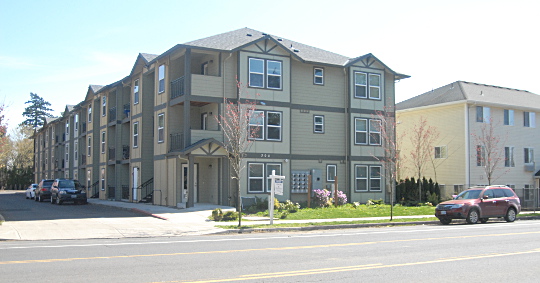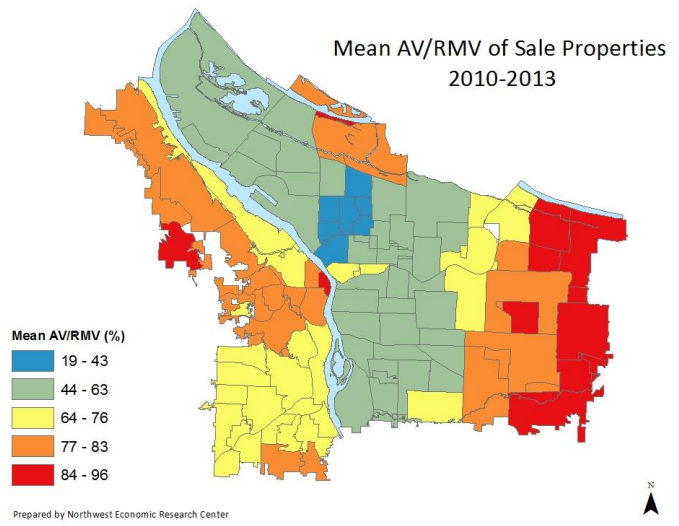
Oregon’s 1997 freeze on taxable property values. The same law drives up the cost of new units
in inner North and Northeast Portland.
Of all the problems with Oregon’s spit-and-chicken-wire property tax system, one of the strangest might be this: It rewards developers who build new apartment buildings in Gresham while driving up the price of new units in inner Northeast.
This redevelopment penalty is an obscure but growing side effect of a system that also props up home prices in the central city and puts a disproportionate tax burden on East Portland and other recently redeveloped areas, the co-author of a new report says.
“In certain cases, it’s a disincentive to develop or invest,” Jeff Renfro of the Northwest Economic Research Center said in an interview Wednesday. “Potentially a pretty significant disincentive.”
For example: Miss Apartments, a 25-unit apartment building built in 2012 on North Mississippi Avenue and Failing Street, paid $49,910 in taxes last year — almost all of which, Renfro said, was probably passed on to tenants due to central Portland’s chronic shortage of rental housing. (Miss Apartments currently has a 0% vacancy rate, a property manager said Friday.)
“If you’re the developer, you have to make up that cost,” Renfro said. “One way to do that is to target higher-income renters.”
Meanwhile, the rented-out house immediately behind Miss Apartments, which was built in 1908 and is still protected by the 1997 tax freeze, pays a much lower property tax rate. For Miss Apartments, the additional cost works out to about $64 per month per unit, about 5 percent of the monthly rent at Miss.
It’s not a huge difference right now, which helps explain why apartment building keeps booming in inner North and Northeast Portland. But if central Portland land values continue to climb faster than those in the rest of Multnomah County, the penalty for redeveloping the central city will keep rising, too — quietly eating away at supply of new homes and storefronts in the highest-demand areas and allowing owners of the existing properties to keep raising rents higher and higher.

(Image: Northwest Economic Research Center)
Meanwhile, the same system would reward developers when they put up big projects in lower-demand areas. (The three-year-old 25-unit apartment building pictured above, on Southeast 148th Avenue, offers units at half the price of Miss Apartments with auto parking included. Its vacancy rate is 8 percent.)
It adds up to a system that makes it more expensive to create new homes and jobs in the walkable, bike-friendly, transit-rich central areas of Portland that are facing such intense demand.
It adds up to a system that makes it more expensive to create new homes and jobs in the walkable, bike-friendly, transit-rich central areas of Portland that are facing such intense demand.
The study Renfro co-authored, funded by the Oregon League of Cities and released Wednesday by NERC, shows that central Portland homes, especially in the formerly redlined neighborhoods of inner Northeast Portland, sell for inflated prices because the 1997 tax freeze left them with persistently lower tax burdens.
There’s an ongoing public conversation about changing Oregon’s complicated (some say “insane”; Commissioner Steve Novick says “outrageous”) property tax law. Gov. John Kitzhaber says tax reform is his top priority as he looks toward a fourth term in office.
But Wednesday’s NERC study also shows why property tax reform is poison to so many voters: even though it could equalize the tax burden and eliminate the current penalty on new development, it stands to reduce the property values of tens of thousands of single-family homeowners.
That’s exactly the problem with today’s system, Renfro said Wednesday.
“It’s not based on some sort of public policy goal,” he said. “It’s based on who bought when.”
— The Real Estate Beat is a weekly column sponsored by real estate broker Lyudmila Leissler of Portlandia Home/Windermere Real Estate. Let Mila help you find the best bike-friendly home.

